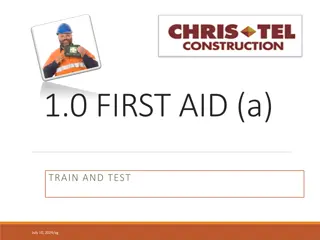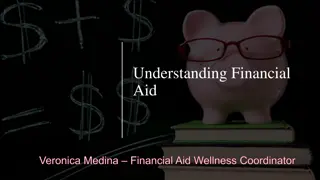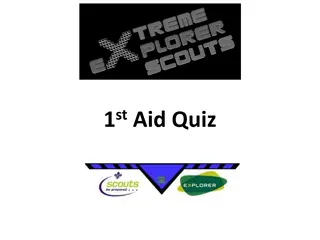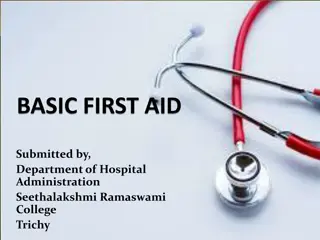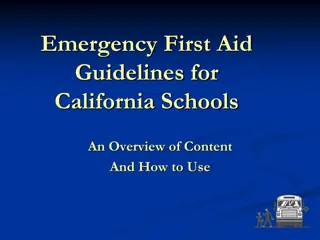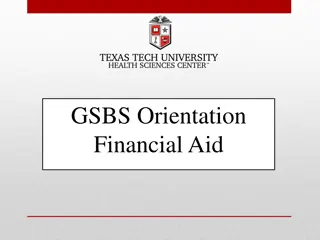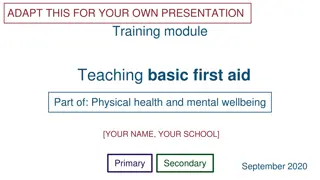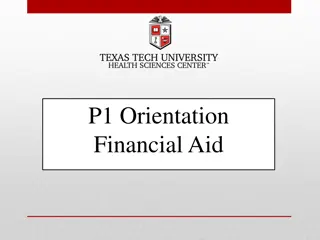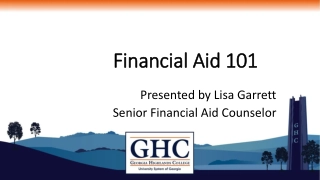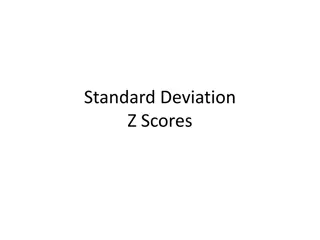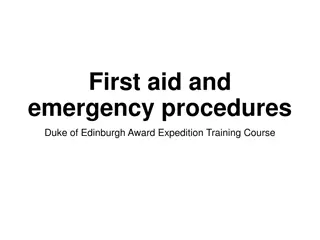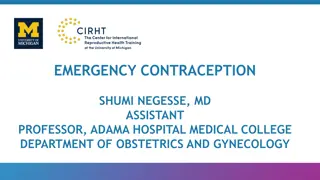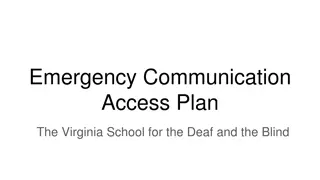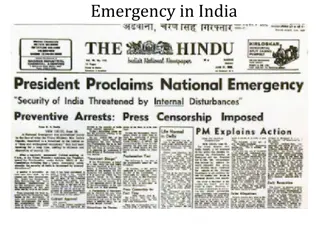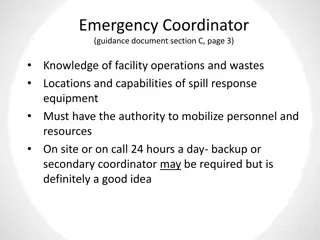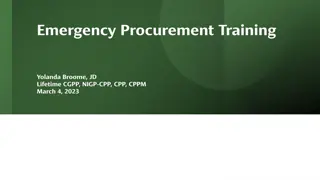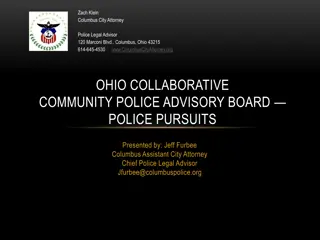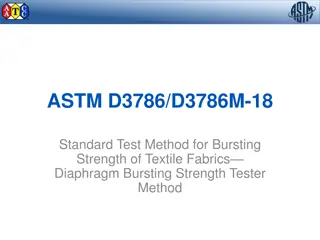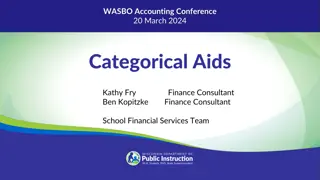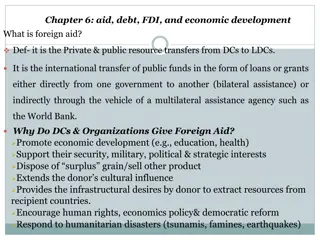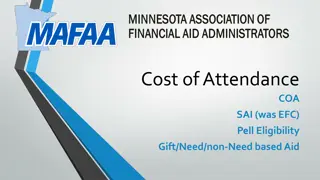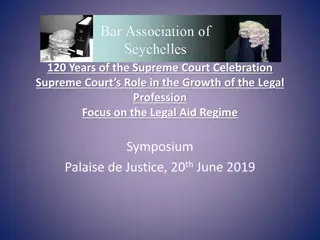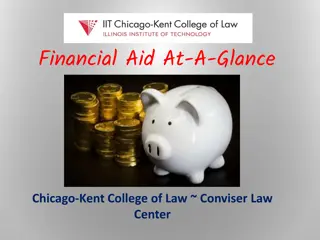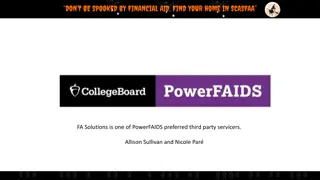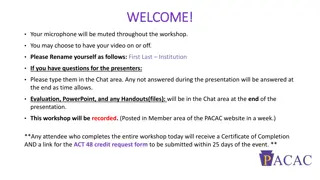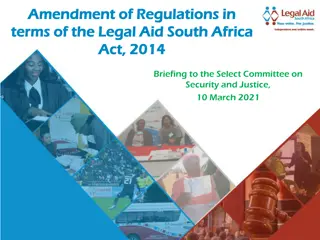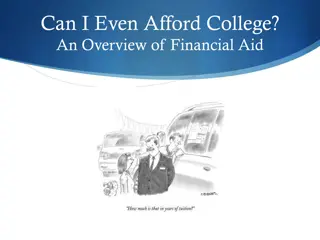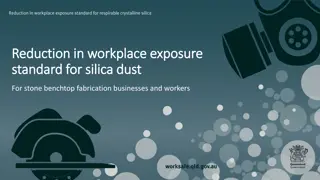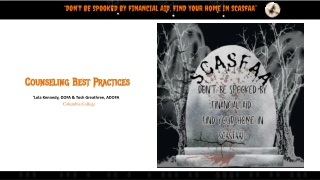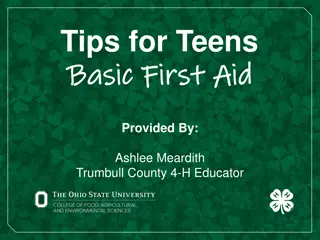Emergency and Standard First Aid Test
This test explores the use of personal protective equipment in emergency first aid situations. Participants are asked to identify the appropriate PPE for first aiders to use when available, with multiple choices provided. The importance of protective measures in emergency care is emphasized in this assessment.
Download Presentation

Please find below an Image/Link to download the presentation.
The content on the website is provided AS IS for your information and personal use only. It may not be sold, licensed, or shared on other websites without obtaining consent from the author. Download presentation by click this link. If you encounter any issues during the download, it is possible that the publisher has removed the file from their server.
E N D
Presentation Transcript
Emergency and Standard First Aid Test 1. What personal protective equipment (PPE) should a first aider use if available? A. Leather gloves B. Goggles and gowns C. Gloves and barrier device D. No PPE is required Life's Emergency Training 2020 1
Emergency and Standard First Aid Test 2. When approaching an emergency situation, a first aider should: A. Stand in the middle of the road and tell all traffic to stop B. Look as you approach the scene for any hazard, notice what happened and recognize how many people are injured C. Drive by and look the other way D. None of the above Life's Emergency Training 2020 2
Emergency and Standard First Aid Test 3. After removing used first aid gloves: A. Dispose of gloves in a biohazard container B. Drop gloves on the ground C. Rinse the gloves off D. None of the above Life's Emergency Training 2020 3
Emergency and Standard First Aid Test 4. Ontario has a Defibrillator Act that protects first aiders. A. True B. False Life's Emergency Training 2020 4
Emergency and Standard First Aid Test 5. While you are eating at a diner, you hear the person behind you coughing and that person screams "I m choking, help". What will you do to help? A. Nothing she is not choking B. Administer 5 back blows and 5 abdominal thrust C. Perform abdominal thrusts until her airway clears D. Introduce yourself, encourage her to cough and stay with her Life's Emergency Training 2020 5
Emergency and Standard First Aid Test 6. You arrive at work and find a co-worker lying at the bottom of 9 steps. The co-worker is unresponsive and bleeding from the head. What should you do to help? A. Tell her not to move, support her head, assign a person to call 911, get the AED and monitor ABC s B. Ask her if she can get up and walk up the stairs to you C. Straighten her neck, move her away from the bottom of stairs and monitor her ABC s until EMS arrives D. Place your coat over her to keep her warm, and get some water for her to drink Life's Emergency Training 2020 6
Emergency and Standard First Aid Test 7. To open an unresponsive casualty s airway lying on their back the first aider must use: A. Recovery position B. Head tilt neck lift C. Head tilt chin lift D. Modified jaw thrust Life's Emergency Training 2020 7
Emergency and Standard First Aid Test 8. Signs and symptoms of a heart attack may include: A. Extremely weak or tired B. Shortness of breath and arm pain C. Jaw pain and neck pain D. All the above Life's Emergency Training 2020 8
Emergency and Standard First Aid Test 9. The correct method to help control a bleed is: A. Use a paper towel and take them to your doctor s office B. Tell them to sit down and let you get your gloves on first C. Have them apply direct pressure and sit down to allow you to get gloves D. Call 911 and wait for EMS to arrive Life's Emergency Training 2020 9
Emergency and Standard First Aid Test 10. When a casualty is choking severely, they: A. Look panicked, unable to talk and often try to leave the area B. Can cough, talk and breath and have flushed skin colour C. Are always unresponsive D. A and B only Life's Emergency Training 2020 10
Emergency and Standard First Aid Test 11. Automated External Defibrillators can only be used on adult casualties (8 years old and up). A. True B. False Life's Emergency Training 2020 11
Emergency and Standard First Aid Test 12. Hands only CPR is ok if you don't have a barrier device. A. True B. False Life's Emergency Training 2020 12
Emergency and Standard First Aid Test 13. You arrive at work and find a worker on the ground. After completing Look and Talk you find she is unresponsive. Your cell phone has no reception. What is the next thing you do as a first aider? A.Leave B. Check for any hazards and tell her "Don't Move" C.Place her in recovery position and go call 911 D.Look for hazards and ask for permission to help Life's Emergency Training 2020 13
Emergency and Standard First Aid Test 14. Place the following action in the correct order to complete a scene survey when responding to an emergency situation as a first aider. A. Look for hazards, MOI, determine how many people are injured, talk to the bystanders helping, call 911, and ask for AED B. Call 911, ask for AED, look for hazards and talk to the casualty C. Open airway check for severe bleeding, and check breathing D.Look for hazards, MOI, determine how many people are injured, talk to any casualties, call 911 & ask for an AED Life's Emergency Training 2020 14
Emergency and Standard First Aid Test 15. Risk factors that may increase your chance of cardiovascular disease include family history, ethnic origins and age. A. True B. False Life's Emergency Training 2020 15
Emergency and Standard First Aid Test 16. All casualties that have a heart attack describe having pain or discomfort. A. True B. False Life's Emergency Training 2020 16
Emergency and Standard First Aid Test 17. When performing CPR, you start with: A. 2 breaths B. 30 compressions C. 15 compressions D. 1 breath Life's Emergency Training 2020 17
Emergency and Standard First Aid Test 18. The first action a first aider must do with the AED when it arrives at a casualty in cardiac arrest is: A. Place pads on bare chest B. Finish 30 compression C. Wait for a trained responder D. Turn the AED on Life's Emergency Training 2020 18
Emergency and Standard First Aid Test 19. If a casualty vomits during CPR the first aider must: A. Stop CPR and use something to scoop out the vomit B. Continue CPR with hands only compressions C. Continue with 30 compressions D. Stop CPR to and roll casualty onto their side and clear their mouth Life's Emergency Training 2020 19
Emergency and Standard First Aid Test 20. When performing CPR on all ages, the compression to breaths ratio is: A. 15:2 B. 30:2 C. 5:1 D. 2:30 Life's Emergency Training 2020 20
Emergency and Standard First Aid Test 21. When performing CPR, the rate is 100 120 compressions per minute. A. True B. False Life's Emergency Training 2020 21
Emergency and Standard First Aid Test 22. When providing first aid treatment for an amputated finger the first thing you do is: A. Stop the bleeding on the amputated finger B. Pick up the amputated finger and put it directly on ice C. Tell the casualty to sit down and apply pressure to their hand D. Get the first aid kit Life's Emergency Training 2020 22
Emergency and Standard First Aid Test 23. A Casualty who may be having a heart attack will: A. Complain of chest pressure or tightness B. Look pale, sweaty and short of breath C. Say the pain is only heartburn D. All the above Life's Emergency Training 2020 23
Emergency and Standard First Aid Test 24. To stop a simple nose bleed, you should tell the casualty to: A. Sit down and lean their head backwards B. Sit down, lean their head forward and pinch soft part of the nose C. Put some paper towels in the nostril to stop bleeding and remove towels in 10 minutes D. Tell the casualty to blow their nose Life's Emergency Training 2020 24
Emergency and Standard First Aid Test 25. To remove a bee stinger from your skin you must: A. Use needle nosed tweezers B. Apply mud and allow the mud to dry C. Scrape stinger out with a flat edge like a bank card D. None of the above Life's Emergency Training 2020 25
Emergency and Standard First Aid Test 26. At break time a co-worker appears drunk. While talking to him he tells you he is a diabetic. What should you do as a first aider? A. Sit the casualty down and call 911 B. Give him insulin injection, then check his blood sugar levels C. Call his spouse to come and get him D. Give him something sugary (glucose, candy or juice) Life's Emergency Training 2020 26
Emergency and Standard First Aid Test 27. You go to say hi to a neighbour but find him leaning to one side of the chair and is drooling from a droopy lip. His speech is slurred, and he cannot move his right arm. He has signs of: A. Too much alcohol B. A stroke C. A heart attack D. A napping individual Life's Emergency Training 2020 27
Emergency and Standard First Aid Test 28. While at home a family member spills boiling water on their hand. The first aid treatment for a 1st and small 2nd degree burn is: A. Rinse with cool water for until not burning B. Apply aloe and cover with gauze C. Tell them they need to go to the hospital D. Cover burns with sterile gauze to hold in the heat Life's Emergency Training 2020 28
Emergency and Standard First Aid Test 29. While in the lunchroom a person at your table starts to cough, is pale and their lips start to swell. This person is possibly having: A. A stroke B. Severe allergic reaction C. Will have a seizure soon D. A diabetic emergency Life's Emergency Training 2020 29
Emergency and Standard First Aid Test 30. A friend is visiting your house and stops talking, then falls to the ground shaking. What do you do as a first aider? A. Watch your friend closely until the seizure ends B. Call Telehealth and ask for help C. Instruct people to roll them into the recovery position and hold your friend s legs down D. Clear the area, have someone call 911and place in the recovery position after seizure is over Life's Emergency Training 2020 30
Emergency and Standard First Aid Test Child and Infant 31. You are alone and performing CPR on a 5-year-old child. When do you leave to get help? A. Never, wait for someone to arrive B. As soon as you know they are unconscious C. After performing up to 2 minutes of CPR D. Take the child with you immediately to find help Life's Emergency Training 2020 31
Emergency and Standard First Aid Test 32. When performing CPR on an infant you must: A. Give 30 compressions pushing 1/3 of their chest depth (4cm) and give normal 2 breaths B. Give 15 compressions pushing 2 inches (5 cm) and give 1 large breath C. Give 5 compressions pushing 1/3 of their chest depth (4cm) and give normal 1 breath D. Just do compressions at the rate of 160 compressions per minute Life's Emergency Training 2020 32
Emergency and Standard First Aid Test 33. While at a birthday party a six-year-old child is flushed red, coughing and looks like he might vomit. You ask him if he is choking and he says "Yes". What do you do as a first aider? A. Get permission from Mom and perform 5 back blows and 5 chest thrusts B. Get permission from Mom and perform 30 chest compressions C. Nothing because he is okay D. Get permission from Mom and encourage the child to keep coughing Life's Emergency Training 2020 33
Emergency and Standard First Aid Test 34. When giving rescue breathes to an infant you must cover the infant s mouth and nose with your mouth. A. True B. False Life's Emergency Training 2020 34
Emergency and Standard First Aid Test Secondary Survey 35. The four vital signs used in first aid are: A. Level of consciousness, colour, movement and breathing B. Mechanism of injury, colour, breathing and pulse C. Movement, breathing, skin and pulse D. Level of consciousness, breathing, pulse and skin Life's Emergency Training 2020 35
Emergency and Standard First Aid Test 36. D. O. T. S. means: A. Delays, open wounds, tenderness and signs B. Deformity, open wounds, tenderness and swelling C. Deformity, open wounds, time and symptoms D. None of the above Life's Emergency Training 2020 36
Emergency and Standard First Aid Test 37. The carotid pulse is checked for an adult casualty. A. True B. False Life's Emergency Training 2020 37
Emergency and Standard First Aid Test Head, Spine and Pelvis Injuries 38. A major organ that may be affected if the casualty has a pelvis injury is: A. Lungs B. Stomach C. Bladder D. Heart Life's Emergency Training 2020 38
Emergency and Standard First Aid Test 39. Signs and symptoms of a suspected back injury may include: A. Memory loss and confusion B. Unable to feel legs C. Pain in back D. Both B and C Life's Emergency Training 2020 39
Emergency and Standard First Aid Test Chest Injuries 40. First Aid treatment for a penetrating chest wound is: A. Place gauze over the wound to stop the bleed B. Place plastic over wound and tape three sides of covering C. Place gauze over wound and tape over wound on all sides D. None of the above Life's Emergency Training 2020 40
Emergency and Standard First Aid Test 41. Embedded objects in a casualty s chest should be: A. Removed from the casualty s chest B. Moved around to see if it is loose enough to take out C. Immobilized with bulky materials D. All the above Life's Emergency Training 2020 41
Emergency and Standard First Aid Test 42. An injury that has 2 or more ribs fractured in 2 or more places is called: A. Femur fractures B. Flail chest C. Penetrating fracture D. Blast fracture Life's Emergency Training 2020 42
Emergency and Standard First Aid Test Heat and Cold Injuries 43. The first aid treatment for a casualty suffering from heat stroke is: A. Place in cool area, fan and mist them B. Place in cool area and give lots of cold drinks C. Place in a cool area and remove all clothing D. Place in a cool area, remove excess clothing and cool rapidly with ice Life's Emergency Training 2020 43
Emergency and Standard First Aid Test 44. When a casualty has mild hypothermia: A. The casualty will shiver B. The casualty will be unresponsive C. The casualty will not know they have a problem D. The casualty will feel warm Life's Emergency Training 2020 44
Emergency and Standard First Aid Test 45. First aid treatment for a casualty with deep frost bite is: A. Seek medical attention B. Injury is not painful, so no treatment is needed C. Replace wet clothing with dry clothing D. Both A and C Life's Emergency Training 2020 45
Emergency and Standard First Aid Test Eye Injuries 46. The first aid treatment for a casualty with any eye injury is: A. Cover the injured eye only B. Attempt to remove any embedded objects C. Attempt to cover both eyes D. None of the above Life's Emergency Training 2020 46
Emergency and Standard First Aid Test 47. An eye that has been knocked out should be replaced immediately to prevent infection. A. True B. False Life's Emergency Training 2020 47
Emergency and Standard First Aid Test Bone and Joint Injuries 48. When assisting a casualty with a suspected fractured ankle, a first aider should: A. Call 911 immediately B. Straighten the leg and splint the injury and move towards EMS C. Get them to rest, immobilize the injury, apply cold and elevate the leg D. All the above Life's Emergency Training 2020 48
Emergency and Standard First Aid Test 49. Slings are used in first aid treatment to: A. Give comfort to the casualty by immobilizing injury B. Allow the casualty to stay home and not have to see a doctor C. Should not be used; slings extend injuries healing time D. None of the above Life's Emergency Training 2020 49
Emergency and Standard First Aid Test 50. A dislocation is: A. A broken bone that has broken the skin B. Tendons that have been over used C. Two bones that have separated D. Another name for an ankle fracture Life's Emergency Training 2020 50


